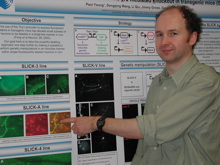2008 Press Releases
09.05.2008
A novel technique to genetically manipulate brain cells in mice has just been published in the leading neuroscience journal Nature Neuroscience by Dr Paul Young of UCC's Biochemistry Department.
This new method is called 'SLICK', standing for Single-neuron Labeling with Inducible Cre-mediated Knockout. Dr Young developed this method in the laboratory of Professor Guoping Feng at Duke University and has further refined it since moving to UCC in 2005. SLICK makes it possible to both visualize brain cells in great detail, and at the same time turn genes on and off in these cells. Elucidating the neural functions of genes is especially challenging because of the complexity of the brain with its billions of tightly packed cells. SLICK is designed to overcome this challenge. By combining the ability to both monitor and manipulate brain cells in mice, SLICK permits the neural functions of genes to be determined with unprecedented precision.
Brain cells called neurons can be regarded as the basic information processing units of the brain. They receive inputs on highly branched cellular extensions called dendrites and send outputs of processed information through their axons. Axons of one neuron are connected to dendrites of other neurons via synapses to form neural circuits. The shape of a neuron's axons and dendrites (its morphology) and the patterns of its synaptic connections to other neurons determine how it processes information. Likewise, changes in the strength of the synaptic connections between neurons are believed to be the basis for information storage in the brain (i.e. learning and memory). Neuronal morphology and synaptic connectivity therefore influence how large numbers of cells assemble into the neural circuits that give rise to the higher cognitive functions of the brain.
SLICK will allow researchers to investigate how genes determine various properties of neurons, such as how they acquire their distinctive shapes and how they make connections to other brain cells. By brightly labeling a very small proportion of the billions of neurons in the brain using a green coloured fluorescent protein it is possible to visualize single neurons among the masses of intertwined and tightly packed cells. One can then turn a gene on or off in these labeled cells and see how the shape and connectivity pattern of the neuron changes. In this manner one can study how genes influence neural circuit formation and function in the brain.
Defects in neuronal shape and synaptic connectivity have been implicated as potential causative factors of several neurological disorders, including Alzheimer's disease, epilepsy and mental retardation. Genetic factors contribute to most neurological diseases, and often many genes influence susceptibility to a particular disease. The human genome project has identified all the genes that comprise our molecular blueprint. The challenge of the "post-genomic era" is to assign and characterize the functions of these genes. SLICK is a research tool designed to overcome this challenge and can potentially be used to study genes involved in a variety of neurological and neurodegenerative diseases.
Visit: http://www.nature.com/neuro/journal/vaop/ncurrent/abs/nn.2118.html
Reference
Young, P., Qiu, L., Wang, D., Zhao. S., Gross, J., Feng, G. (2008) "Single-neuron labeling with inducible cre-mediated knockout in transgenic mice" Nature Neuroscience advance online publication. 04 May 2008 (doi: 10.1038/nn2118)
Picture: Dr Paul Young
724MMcS

